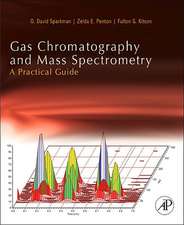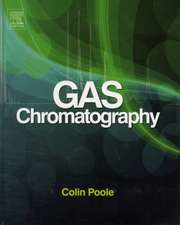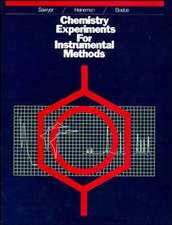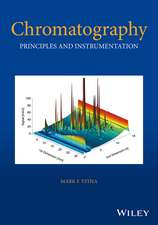Chiral Recognition in Separation Methods: Mechanisms and Applications
Editat de Alain Berthoden Limba Engleză Paperback – 12 oct 2014
| Toate formatele și edițiile | Preț | Express |
|---|---|---|
| Paperback (1) | 1219.46 lei 6-8 săpt. | |
| Springer Berlin, Heidelberg – 12 oct 2014 | 1219.46 lei 6-8 săpt. | |
| Hardback (1) | 1224.36 lei 6-8 săpt. | |
| Springer Berlin, Heidelberg – 23 iun 2010 | 1224.36 lei 6-8 săpt. |
Preț: 1219.46 lei
Preț vechi: 1487.15 lei
-18% Nou
Puncte Express: 1829
Preț estimativ în valută:
233.36€ • 241.10$ • 194.12£
233.36€ • 241.10$ • 194.12£
Carte tipărită la comandă
Livrare economică 19 martie-02 aprilie
Preluare comenzi: 021 569.72.76
Specificații
ISBN-13: 9783642423697
ISBN-10: 3642423698
Pagini: 352
Ilustrații: XIV, 337 p.
Dimensiuni: 155 x 235 x 18 mm
Greutate: 0.49 kg
Ediția:2010
Editura: Springer Berlin, Heidelberg
Colecția Springer
Locul publicării:Berlin, Heidelberg, Germany
ISBN-10: 3642423698
Pagini: 352
Ilustrații: XIV, 337 p.
Dimensiuni: 155 x 235 x 18 mm
Greutate: 0.49 kg
Ediția:2010
Editura: Springer Berlin, Heidelberg
Colecția Springer
Locul publicării:Berlin, Heidelberg, Germany
Public țintă
ResearchCuprins
Chiral Recognition Mechanisms in Enantiomers Separations: A General View.- Preparation and Chiral Recognition of Polysaccharide-Based Selectors.- Description and Evaluation of Chiral Interactive Sites on Bonded Cyclodextrin Stationary Phases for Liquid Chromatography.- Cyclofructans, a New Class of Chiral Stationary Phases.- Chiral Recognition and Enantioseparation Mechanisms in Capillary Electrokinetic Chromatography.- Chiral Recognition Mechanism: Practical Considerations for Pharmaceutical Analysis of Chiral Compounds.- Chiral Recognition with Macrocyclic Glycopeptides: Mechanisms and Applications.- Vancomycin Molecular Interactions: Antibiotic and Enantioselective Mechanisms.- Enantioselective Recognition in Solution: The Case of Countercurrent Chromatography.- Enantioselective Properties of Nucleic Acid Aptamer Molecular Recognition Elements.- Chiral Ionic Liquids in Chromatographic Separation and Spectroscopic Discrimination.
Recenzii
From the reviews:
“I strongly recommend this book to those interested in understanding the mechanisms responsible for chiral recognition in chromatographic and electrophoretic techniques. … This book may be of interest both to beginners and to confirmed practitioners in the field. … Chiral recognition in separation methods is a valuable book compiling a detailed description of most of the essential chiral selectors employed in chromatographic and electrophoretic techniques. … Both students and practitioners interested in enantiorecognition mechanisms should have it in their library.” (Caroline West, Analytical and Bioanalytical Chemistry, Vol. 400, 2011)
“I strongly recommend this book to those interested in understanding the mechanisms responsible for chiral recognition in chromatographic and electrophoretic techniques. … This book may be of interest both to beginners and to confirmed practitioners in the field. … Chiral recognition in separation methods is a valuable book compiling a detailed description of most of the essential chiral selectors employed in chromatographic and electrophoretic techniques. … Both students and practitioners interested in enantiorecognition mechanisms should have it in their library.” (Caroline West, Analytical and Bioanalytical Chemistry, Vol. 400, 2011)
Textul de pe ultima copertă
The importance of chiral interactions for both preparative and analytical separations, particularly for pharmaceutical applications, is underlined by numerous publications in this field. Here, for the first time, a team of experienced analysts from industry and academe presents a comprehensive review of the various mechanisms that result in enantiomer separations. A better understanding of these processes is crucial for setting as well as improving chiral separation procedures and also for developing new applications. The coverage in this book includes a range of separation methods, such as gas, liquid, or countercurrent chromatography, and capillary electrophoresis. The special case of chiral ionic liquids is examined in detail. Most modern chiral selectors are discussed, including derivatized polysaccharide- and cyclodextrin-based selectors, along with a newly introduced class of carbohydrates: the cyclofructose selectors.This publication will be required reading not only for research and development departments in the pharmaceutical and cosmetic industries, but also for researchers in toxicology, environmental monitoring, and food research.
Caracteristici
The first monograph to focus on the mechanisms of chiral selection in separation processes Important reading for research and development departments of the pharmaceutical industry, but also for researchers in toxicology, environmental monitoring, or food research Written by a team of experienced experts from industry and academe Includes supplementary material: sn.pub/extras








